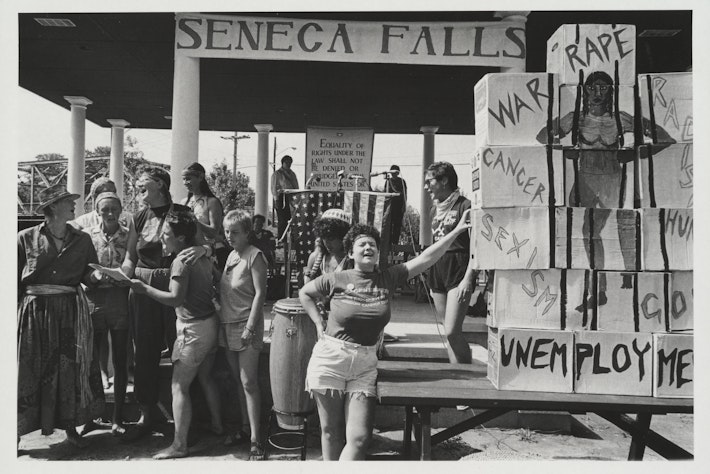Decoding "Taking an Airing"
Many thanks to readers who responded to our request for help in decoding “Leaders of the Woman’s Rights Convention Taking an Airing.” We’ve yet to hear from anyone who has ever seen it before.
Many thanks to readers who responded to our request for help in decoding the recently acquired 1848 print “Leaders of the Woman’s Rights Convention Taking an Airing.” We’ve yet to hear from anyone who has ever seen it before. All agree that this image was not meant to be flattering. Quite the opposite—it is a send-up of early feminists who have lost control of themselves and their horses.
The historian Beverly Palmer, whose most recent work is on Lucretia Mott (who helped write the Declaration of Sentiments at Seneca Falls in July 1848), is confident that the figures here do not depict “real” women: not Mott, Elizabeth Cady Stanton, or any of the other women in attendance. “Taking an airing,” Elyse Moore of Historic Deerfield points out, denoted a pleasant perambulation. The mercurial and chaotic outing of these women’s rights advocates is, of course, the very opposite of leisurely. Moore also wonders whether the four horsewomen could be a play on the Four Horsemen of the Apocalypse, whose appearance will herald the End of Days.
Robin Bledsoe, of Robin Bledsoe Bookseller (ABAA), in Cambridge, which specializes in equestrian books and ephemera, notes that in 1848 it was very unusual—and slightly scandalous—to portray women riding astride instead of sidesaddle and explains much about both horses and riders. The young woman in the left foreground, for example, seems to have her act together but does not—her horse’s head betrays its resistance. She strikes a very masculine, military pose and seems almost prim in her collared dress—but her skirt is hitched up to reveal quite a bit of booted leg, which is anything but. Her odd, helmetlike hat is actually a jockey’s cap, not unheard of on a woman but definitely masculine.
The woman in the center is completely undone. Her horse has stolen her bonnet, whose style suggests she might be a country woman, and her comb has come loose from her hair. Her skirt, too, is hiked up, revealing her ankles and tiny feet. The woman on the right is holding on for dear life to a galloping mount, probably a horse meant for pulling a cart rather than carrying a rider (you can tell by its clipped mane and cropped tail). If she had a hat, it has blown away. Her hair is a mess, her dress is billowing behind her, and she’s showing not just foot, ankle, and calf but knee. The woman riding away astride her horse is wearing a proper hat and riding outfit, although she, too, is showing some leg. Do the whips held by two of the women suggest anything? Probably not. While these were more often stiff and straight rather than bent and floppy in prints of the era, whips with dangling “ticklers” weren’t uncommon.
It’s clearer than ever that the artist James Baillie meant to do the women who attended the Woman’s Rights Convention no favors. We appreciate all the help with decoding the digs in his drawing and suggestions about the bigger picture. The door is always open for more ideas. If you have one, or if you’ve seen this print before (we really, really hope not!), please e-mail kjacob@radcliffe.harvard.edu.







